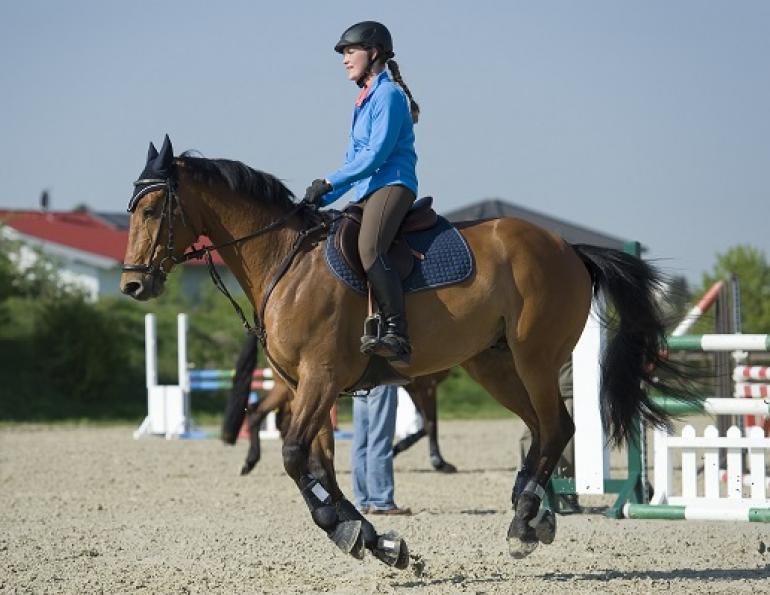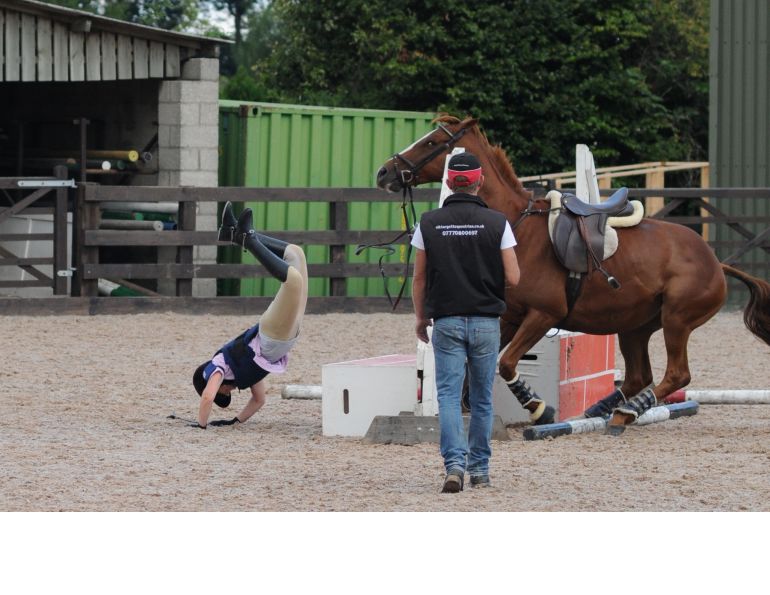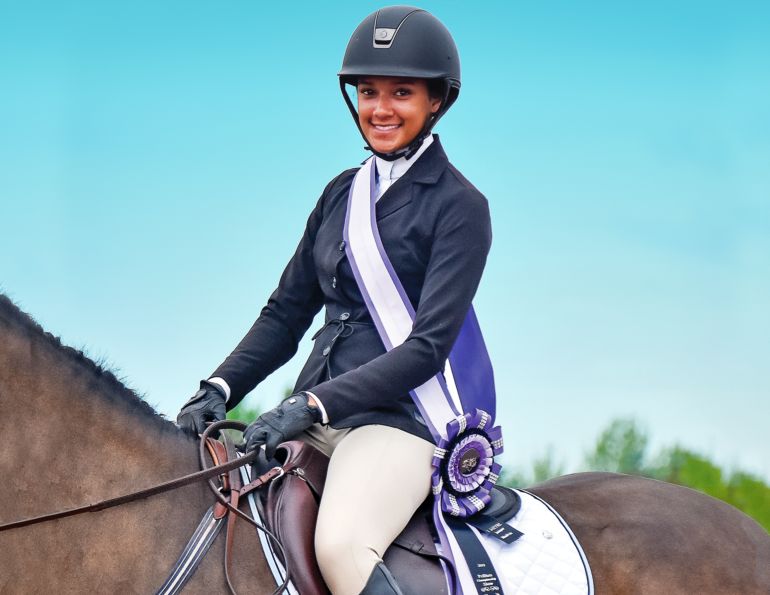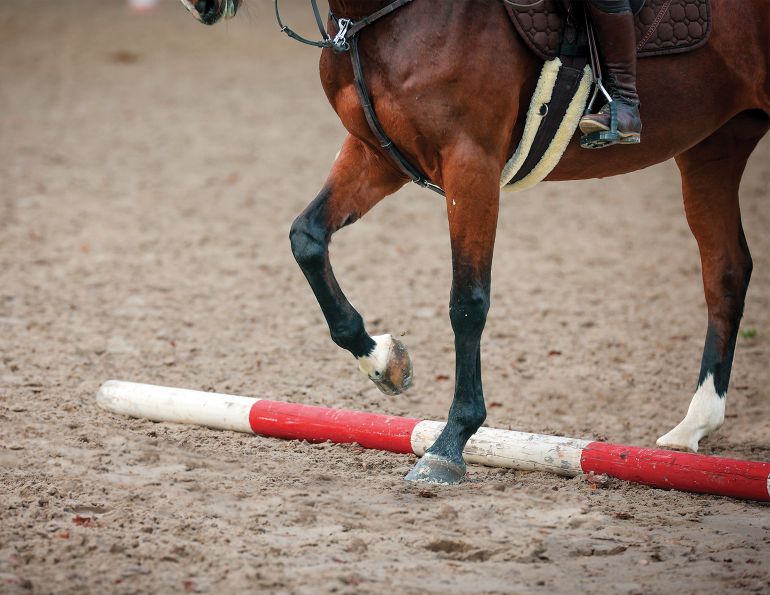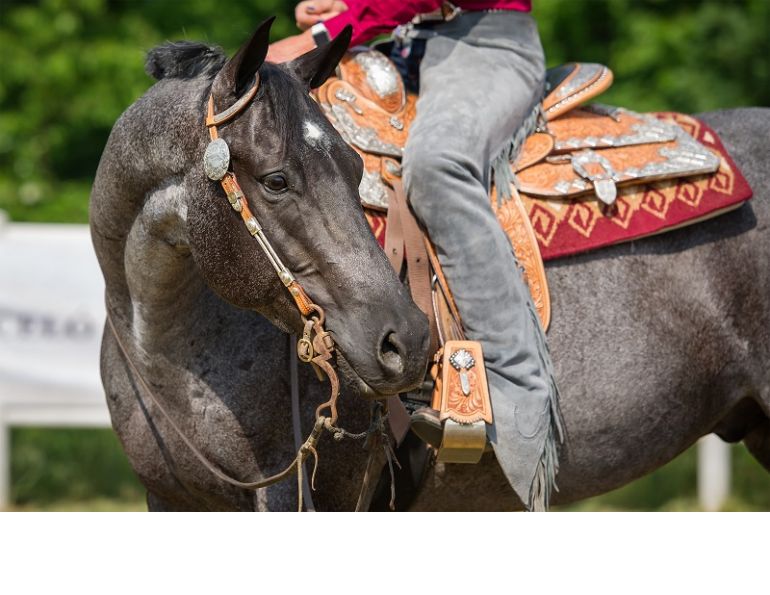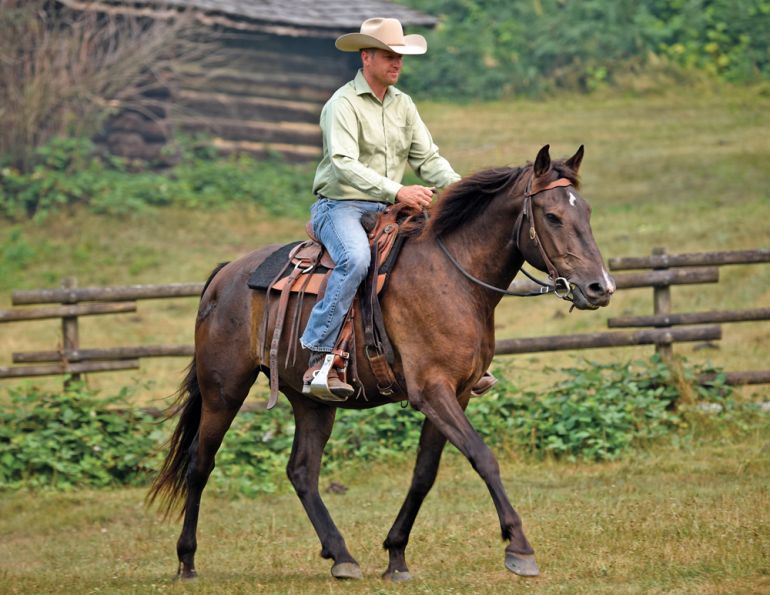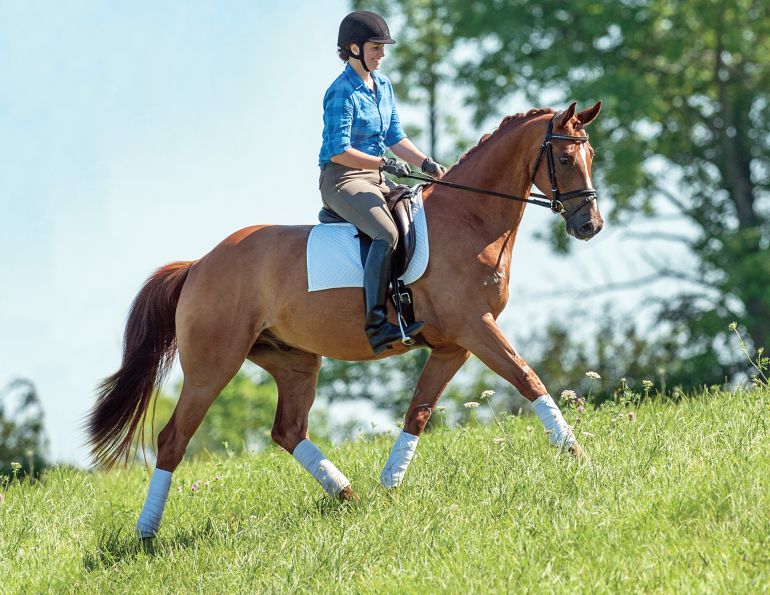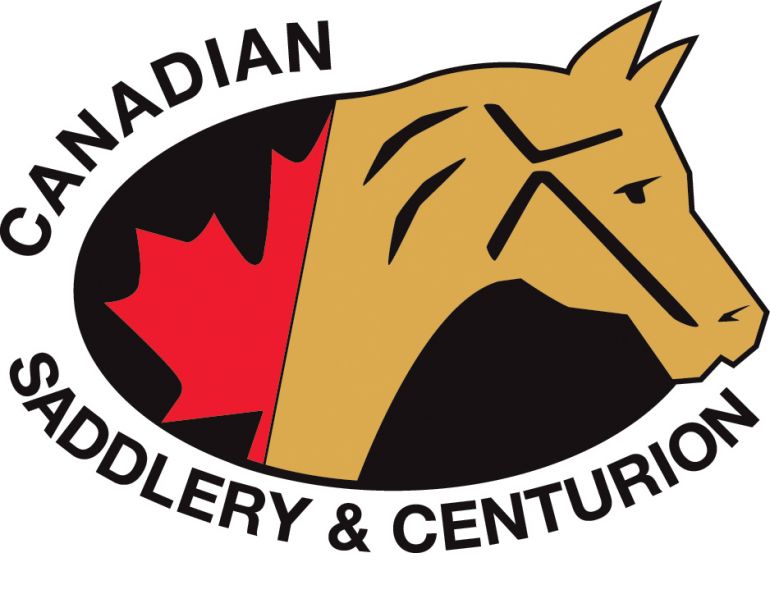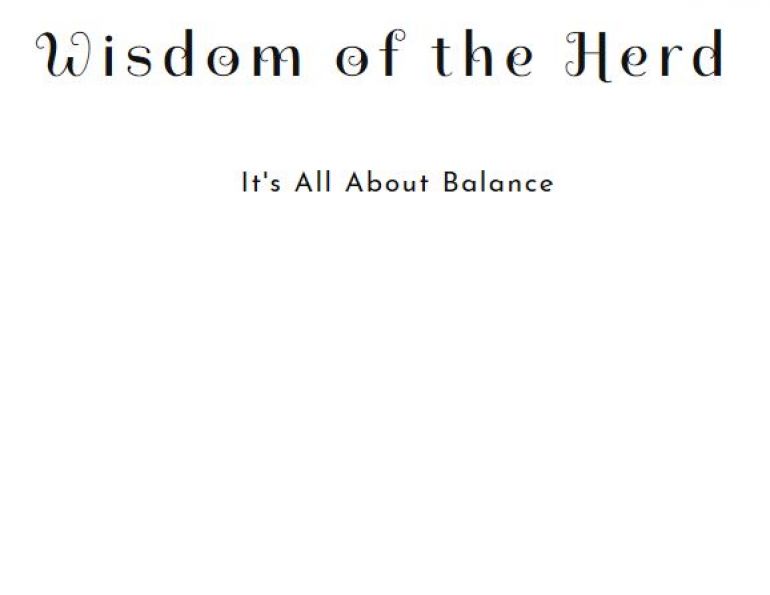By Lori K. Warren, Ph.D.
If you’ve ever been to a gym after a long absence or started up a new exercise routine as part of your New Year’s resolution, you have a good appreciation for the importance of gaining and maintaining fitness. The same concept applies to your horse when you put him back into training after giving him the winter off, after a layoff from an injury, or when starting a young horse under saddle. Unfortunately, many horse owners and trainers are concerned only with working their horses over obstacles or schooling maneuvers specific to their sport, rather than ensuring their horses are fit enough to perform such tasks.
Schooling vs. Physical Fitness
Schooling horses can, and does, help build and maintain physical fitness. However, we must remember that it is not just the horse’s mind we are working, but also the musculoskeletal system. Horses that lack sufficient cardiovascular fitness and strength are at greater risk of injury. A horse can quickly be pushed to the point of physical failure because he is tired or not fit enough to withstand the schooling we are trying to accomplish. In contrast, a horse that is fit for the task will have the stamina to withstand long, strenuous training sessions, as well as greater strength and coordination for improved performance.
Defining Your Training Goals
One of the first steps in designing a conditioning program for your horse is to define your training goals. From a fitness perspective, it is helpful to identify the demands of the sport or activity the horse will be used for. What will he be expected to do in competition? Will improved stamina, speed, or strength be needed to achieve your performance goals?
Stamina generally refers to endurance or aerobic capacity, which is necessary for submaximal, more prolonged activities such as endurance riding, eventing, hunter/jumper, ranch work, reining, dressage, frequently used lesson horses, and recreational or pleasure riding. By comparison, speed and strength both characterize the anaerobic capacity needed for maximal intensity and/or high power activities performed for shorter periods of time. Speed is important for racing, rodeo timed events such as roping and barrel racing, and polo. Some level of improved strength is useful for all equine sports, but is especially important for dressage, jumping, draft work, driving, and cutting. Few equine sports rely on just one area, but identifying whether stamina, speed, or strength is most important for success will allow you to focus training to improve that characteristic.
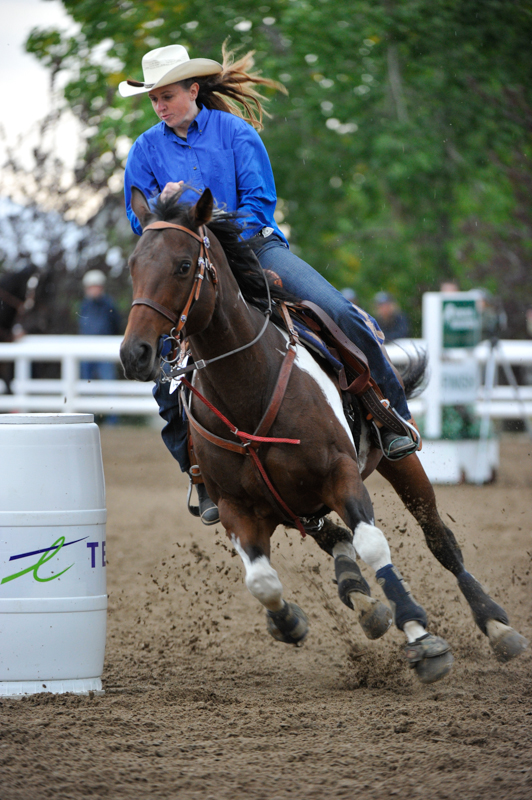
The first step to designing your horse’s training program is to identify the demands of the activity he will be used for. Top photo: Speed is essential for timed events such as barrel racing. Bottom photo: Top level show jumpers require strength, speed and stamina to negotiate grand prix courses during a jump-off.
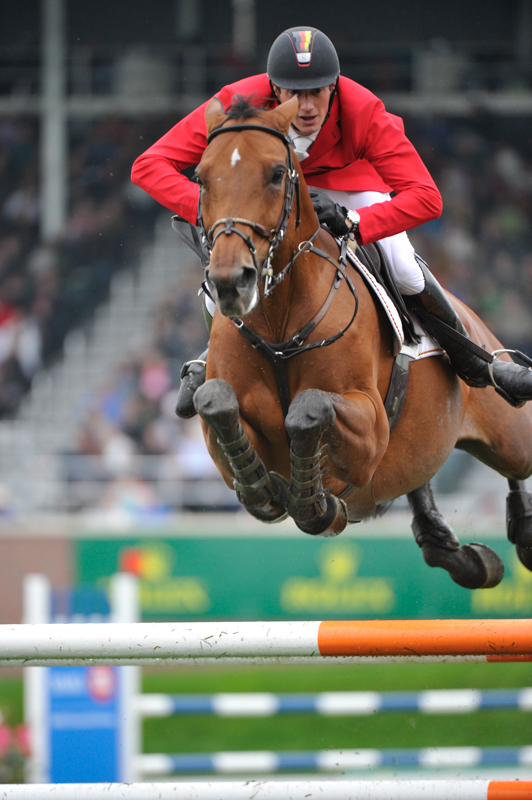

This team of Clydesdales demonstrates the strength needed to pull a wagon uphill. Photos: Robin Duncan Photography
Principles of Conditioning
In order to develop an appropriate training program for your horse, it is important to understand the principles of conditioning that will improve fitness. The following four principles of conditioning should be followed at all stages of training:
1. Progressive Loading: To achieve conditioning, the horse must be subjected to gradual increases in training load. A given workload will result in a certain level of fitness. Without a further increase in training load, there will be no further increase in fitness. For example, a horse’s musculoskeletal system will eventually adapt to an applied workload of 20 minutes of trotting in a round pen. This level of fitness will not increase unless the horse is asked to perform more work. So if my goal is to have the horse canter for 20 minutes in a round pen, I need to gradually work up to this heavier workload in a step-wise fashion.
In general, there are three ways to increase workload: (a) increase duration (time or distance covered); (b) increase intensity (speed or heart rate); and (c) increase frequency. To increase fitness, the workload needs to be applied two to three times per week, whereas to maintain fitness the workload may only need to be applied one to two times per week. Due to the greater risk of injury with higher intensity workouts, it is important to increase duration before speed when adjusting workload. Every time you increase speed, back off on the duration and frequency of workouts.
Related: Ride with Balance, Flexibility & Strength
2. Specificity: Training should mimic competition as much as possible. If speed is critical, train for speed. If strength and endurance are critical, then training should be designed to improve these characteristics. The principle of specificity does not, however, mean the horse has to execute the exact activity or maneuvers he will be expected to perform in competition during every training session. Not only might this lead to repetitive use strain in the back and limbs, it can also be mentally dulling. Instead, the goal is to simulate the likely stresses, strains, and intensity involved in the sport without actually reproducing the competition workloads that could result in injury. Look at this as an opportunity to be creative with your training sessions.
As a form of cross (discipline) training, you could incorporate training methods used in other disciplines that work the same muscle groups important to your sport. Break down the tasks the horse must perform in your sport into smaller elements and explore how you can apply different training techniques to accomplish that same training effort. For example, if you compete in barrel racing or roping, you might incorporate cavaletti or gymnastic jumping into your training to build strength and power in your horse’s hindquarters. If your sport is dressage or hunter/jumper, consider uphill and downhill work (or even backing up hills) to encourage the horse to engage its hind end. Suppling exercises common to dressage, side-passing and leg yielding, reining patterns, and trail obstacles can be a fun way to improve strength and motor skill and add variety, even if your sport does not utilize the specific maneuvers you are exploring. The idea is to focus on the muscle groups that need to be worked or the intensity you are trying to achieve, and to mimic these outcomes without performing the same old daily routine.
You can also find ways to increase heart rate (which represents an increase in workload intensity) without increasing speed and stress on joints and tendons. For example, hill work at a walk or trot is a great way to add intensity (increase heart rate) without adding speed. Pulling logs or a drag or even adding weights to the saddle or surcingle can also increase heart rate to a level associated with fast gaits, even while the horse is performing the activity at a slower gait. Swimming and walking or trotting the horse through 10 to 30 centimetres of water or snow can also increase heart rate to levels you would normally see at a canter or gallop. Even asking for more impulsion or extending the walk or trot can increase heart rate without the same risk for injury that would be seen at similar heart rates at a canter or gallop.
3. Adequate Rest: Each new increase in training load will cause some damage to muscle, bone, and soft tissues since they are not yet accustomed to the higher workload. Through repeated cycles of damage and repair, tissues will adapt to the workload. This is the adaptation process and it takes place during lighter training and/or during sleep. Thus, there is a need to incorporate rest and “easy” days into your horse’s workout schedule. As a general rule, horses should not perform the same type of conditioning on consecutive days. For example, say you increase the workload you give your horse on Monday as part of your progressive loading plan. On Tuesday, you should work your horse with an easier activity that he is already conditioned for. On Wednesday, you can re-apply the training load you introduced on Monday. On Thursday you could give the horse the day off and start again with the training load on Friday, followed by an easy day on Saturday and another day off from work on Sunday. This strategy can also be applied to different types of work. For example, you might choose to work on cardiovascular conditioning on Monday, Wednesday, and Saturday, strength exercises on Tuesday and Thursday, and complete rest on Friday and Sunday.
The concept of “tapering” is related to the principle of providing adequate rest. Tapering involves reducing the workload three to seven days prior to competition. This strategy is proposed to allow adequate tissue repair to reduce likelihood of injury during competition. In contrast, a single day of rest or reduced workload is not sufficient to allow this to occur.
4. Individual Differences: Each horse will respond differently to training, just as people exposed to similar exercise programs will respond differently. Where one horse can progress through a conditioning program at a faster pace without problems, another horse may take longer to adapt to a given workload. Some of this variation is due to genetic capacity; for example, a Thoroughbred is genetically more equipped for racing training than a Shetland pony. The age of the horse, the state of fitness at the beginning of the conditioning program, and the training methods used will also impact the ability of a horse to respond to training. Ultimately, the training program must be individualized in order to attain maximum benefit while minimizing risk of injury.
Related: Using Fitness for Better Balance & Relaxation
Phases and Components of Conditioning
All training programs should progress in phases. In general, there are three phases of conditioning: (1) long, slow distance work; (2) sport-specific conditioning; and (3) high speed work (if applicable).
Phase 1 – Long, Slow Distance (LSD): Commonly referred to as “legging up,” LSD training is characterized by low intensity exercise with a gradual increase in duration. LSD comprises the initial stages of cardiovascular training with the purpose of preparing muscles, bones, and soft tissues for exercise. The goal of LSD is to prepare the horse to cope with 60 minutes of walking and trotting (average speed 8 to 10 kilometres per hour) interspersed with two to three minute bouts of cantering (average speed 16 to 20 kilometres per hour). The duration of LSD workouts might last 15 to 20 minutes per day to start and gradually increase to 60 minutes per day.
In the early stages of LSD, workouts are generally performed five to six days per week, whereas in the latter stages, LSD might occur two to three days per week. The length of the LSD phase will depend on how physically fit the horse is at the start, the age of the horse, and the intensity of the sport for which the horse will be used. For example, the LSD phase may last one to two months for a mature horse with some previous level of fitness; in contrast, it can take three months to one year for a young horse entering training for the first time. The more intense the sport or the longer the horse has been out of training, the longer the LSD phase needs to be to lay a proper foundation. It is worth noting that keeping the horse moderately fit throughout the year (which may only take one to two workouts per week) can prevent the need for a period of LSD training at the start of each competition season.
Phase 2 – Sport-Specific Work: According to the principle of specificity, conditioning should mimic the speed and movements of the sport. Thus, this phase of training introduces the type of work the horse will perform during competition. Sport-specific work should contain three components: (a) cardiovascular conditioning; (b) strength training; and (c) suppling exercises.
Cardiovascular conditioning is a continuation of the training started in the LSD phase. Cardiovascular workouts should be designed to stimulate the metabolic systems needed for the specific sport. A heart rate monitor can be a useful tool for monitoring intensity and workload of cardiovascular conditioning so that specific metabolic systems (aerobic or anaerobic) can be targeted. To improve aerobic capacity, the horse should be trained at heart rates of 150 to 180 beats per minute (trot, canter, or gallop). To improve anaerobic capacity, the horse should be trained at heart rates above 180 beats per minute (canter, gallop, or sprint). Following the principle of progressive loading, the volume of work should be increased gradually by manipulating the workout duration, intensity, and frequency. Remember that intensity is not just speed; intensity (reflected by heart rate) can be increased without changing pace.
To gain fitness, cardiovascular conditioning should be performed two to three times per week. As training progresses, it may be necessary to limit cardiovascular conditioning to twice weekly so that intensity and duration can be increased while still allowing adequate time for tissue repair. Once the horse has achieved the desired level of fitness needed to be successful in a specific sport, cardiovascular workouts need only be performed once or twice weekly to maintain fitness.
Strength training should begin early in sport-specific training, before high speed work (phase 3) to reduce risk of injury. There are two primary objectives for strength training: an increase in muscle endurance (aerobic strength) or an increase in muscle power (anaerobic strength). Muscle endurance is usually important for submaximal activities such as dressage, eventing, hunter/jumper, and reining. In contrast, muscle power is typically desired for maximal activities such as racing, roping, barrel racing, polo, and stadium jumping.
Similar to cardiovascular conditioning, strength training should follow the principle of progressive loading whereby the volume of strength work performed should be increased gradually. Strength exercises might include:
- hill work
- gymnastic jumping (low jumps for endurance, higher jumps for power)
- pulling loads or other draft work
- repetitions of dressage movements (e.g. gait transitions, pirouettes, passage, piaffe, etc.)
- maneuvers specific to the sport that require strength
- torque work (trotting or cantering in progressively smaller circles)
To improve strength, strength training exercises should be performed two to three times per week (alternating days with cardiovascular training works well and follows the principle of adequate rest). To maintain strength, exercises can be performed once per week.
Suppling exercises help to maximize flexion and lateral bending, thus increasing range of motion in joints. These exercises can also improve stride length and engagement of the horse’s hindquarters. Suppling exercises can be dynamic or passive. Dynamic suppling involves the use of turns, circles, voltes, and lateral work (leg yielding, shoulder-in, travers, renvers, half pass, etc.). By comparison, passive suppling can be achieved by physically stretching and bending the horse’s limbs and lateral bending of the horse’s neck (via gentle rein pressure or carrot stretches). Suppling exercises can be performed after a warm-up or at the end of a workout, as well as during “recovery” periods allowed while performing cardiovascular or strength training.
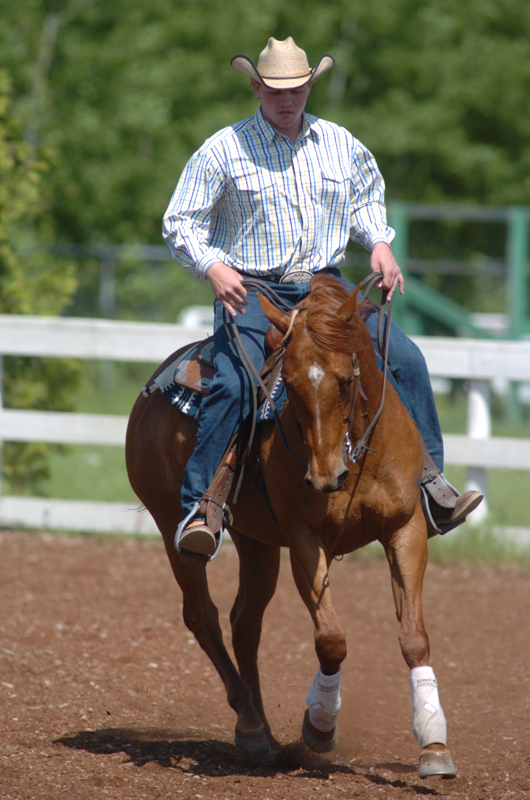
Photo (above): Nikki tate/Flickr
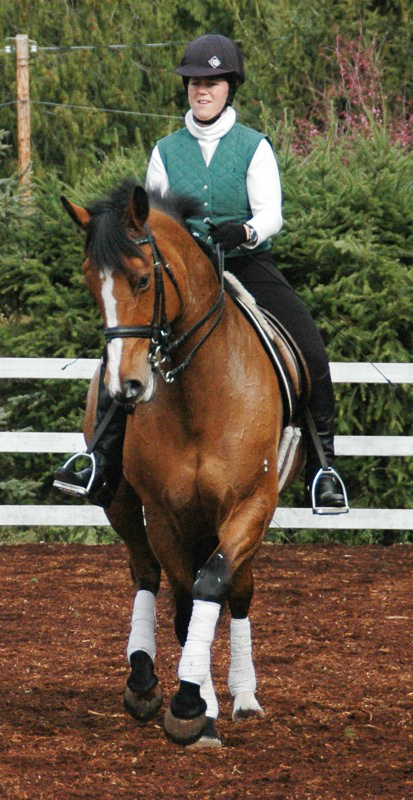
Suppling exercises, such as turns, circles, and lateral work, maximize flexion and lateral bending, increase range of motion in the joints, and improve engagement and coordination. Photo: Robin Duncan Photography
Related: The Equestrian Athlete: An Interview with Olympic Gina Smith
Phase 3 – High Speed Work: Not every equine sport requires sprinting or bursts of speed. However, for those that do, the third phase of a conditioning program will focus on high speed work performed for short durations or distances. Speed work will become a component of the horse’s sport-specific cardiovascular training. The risk of injury is highest with speed work, so this phase of conditioning should only be undertaken when the horse has a reasonable level of cardiovascular fitness and strength. In addition, risk of injury will be reduced if speed work is performed in small segments, rather than one long burst of speed.
“Speed play” is one way high speed work can be incorporated into the training program. Speed play consists of acceleration for 20 to 400 metres, followed by deceleration back to the original canter or slow gallop. A modification of speed play is “acceleration sprints,” whereby the horse is asked to sprint starting from a standstill rather than from a canter. Acceleration sprints also usually involve more rapid acceleration and deceleration compared to speed play. Another option is “turning drills,” where the horse is asked to sprint for a short distance, turn 180 degrees, and then sprint in the opposite direction. Progressive loading can be accomplished in any of these high speed drills by: 1) increasing the number of accelerations and decelerations (i.e. the number of repetitions performed in a given workout); 2) increasing the distance of accelerations; and 3) increasing the speed of accelerations.
Remember that you can increase intensity without increasing speed (e.g. via hill work, adding weight, etc.). Performing work at higher heart rates without higher speed will condition the cardiovascular system for high intensity work and is a good way to help prepare a horse for the high speed work phase. However, if your sport requires speed, you will still need to mimic that component to train bone and soft tissue to withstand the mechanical demands of speed work. This does not mean a horse has to run at racing speed for a mile, even if that is the type of activity that will be performed during competition. Instead, several repetitions of high speed galloping can be performed over shorter distances (15 to 20 strides) with slower canter or gallop in between repetitions.
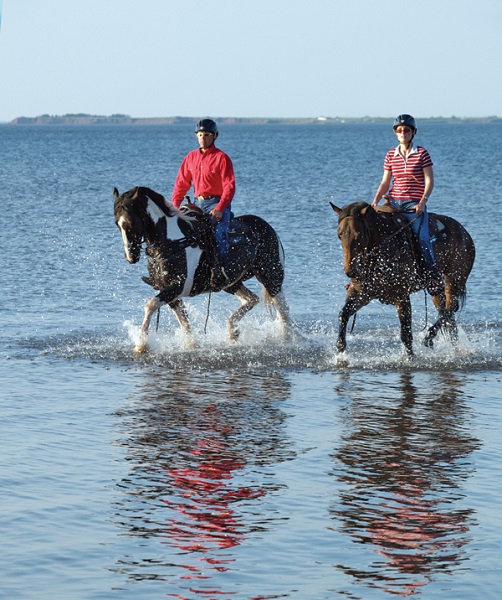
It is possible to increase your horse’s heart rate (which represents an increase in workload intensity) without increasing speed and stress in joints and tendons. Options you may wish to consider include walking or trotting through 10 to 30 centimetres of water or snow, pulling a log or drag, and hill work at a walk, trot, or slow canter. Photo: Pam MacKenzie
Interval Training
Many horses are trained with a “continuous training” format where a fairly constant intensity of exercise is performed over a period of time. A popular and effective training format used in human athletes is “interval training.” Although interval training is gaining some attention in the horse industry, it has yet to be adopted by many trainers.
Interval training is characterized by short periods of exercise, called “works,” alternated with “recovery” intervals which allow partial, but not complete recovery of heart and respiration rates. The number of works performed is called a repetition, or “rep.” Blocks of works and recoveries constitute a “set” and are interspersed with longer, more complete rest periods called “set rests” (Figure 1).

By dividing the workload into a series of short bouts of more intensive exercise, the horse will be able to perform more total work per day than in a single bout of continuous exercise. In addition, the risk of fatigue-related injury will be reduced. For example, a continuous bout of exercise might be galloping a horse for 1000 metres. With interval training, we can split this up into three reps of 400 metres each (with total distance covered of 1200 metres).
Progressive loading can be applied within the interval training format by: 1) increasing the duration or intensity of works; 2) decreasing the duration of recovery intervals or set rests; 3) increasing the number of works per set (i.e. reps); or 4) increasing the number of sets per day.
The interval training format can be used with aerobic (submaximal, prolonged activities) or anaerobic (power and speed) conditioning. Aerobic interval training generally involves a work to recovery ratio of 1:2, 1:1, or 2:1. In contrast, anaerobic interval training requires a greater period of recovery from very intense works, resulting in work to recovery ratios of 1:5 or 1:6. The interval training format can also be applied to cardiovascular or strength training. In addition, suppling exercises can reasonably be performed during rest intervals.
Assessing Gains in Fitness
A relatively easy to perform, yet valuable index of fitness is your horse’s heart rate after a period of recovery from exercise. When a horse is more physically fit, it should have a lower heart rate (faster recovery) after exercise has ceased compared to the heart rates documented when the horse was less fit (Figure 2). Recovery heart rates are a more reliable indicator of fitness if the exercise performed just prior to heart rate evaluation is standardized as much as possible (i.e. speed, terrain, distance covered, volume of work performed, outdoor temperature, rider weight, etc.). For example, your standardization might involve cantering your horse in a round pen for three minutes before heart rate measurements are obtained, and you would want the horse to canter at the same relative speed each time you performed this test. Alternatively, you could evaluate heart rate following a set of interval training where you routinely perform the same types of exercise. Once the standard exercise bout is complete, obtain a heart rate at one, five, and 15 minutes during recovery. Note that heart rates in the first five minutes post-exercise are least likely to be influenced by excitement and serve as the best gauge of ability to recover. Alternatively, you can pick a fixed heart rate value (e.g. 60 or 80 beats per minute) and time how long it takes for the horse’s heart rate to drop to this value. Normally heart rate declines fairly rapidly during the first few minutes after exercise, and then more slowly until recovery is complete. Persistent elevation of heart rate following exercise may be indicative of dehydration or exhaustion. Elevated heart rate above what is normal for your horse may also be an early indicator of lameness or illness.
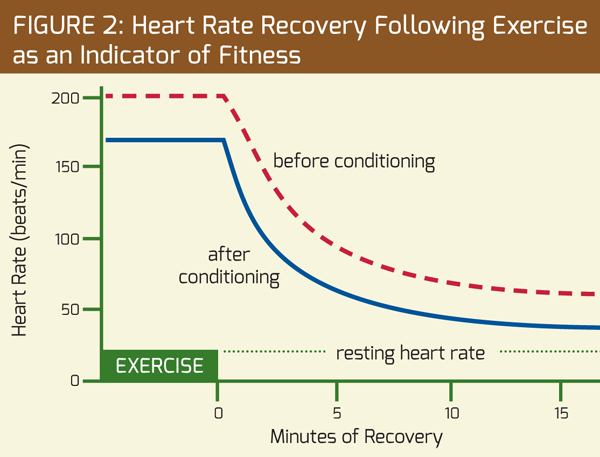
Measuring your horse’s heart rate does not require special equipment, but can be determined by taking a pulse behind the knee, the rear of the pastern (digital artery), or under the jaw bone (facial artery). Alternatively, there are relatively inexpensive (starting around $100) onboard heart rate monitors that offer the same technology used in human devices. The advantage of these monitors is that they can be used to get real-time heart rate readings during exercise that can assist in training (Table 1). Additionally, an evaluation of heart rate can be performed during exercise or recovery without having to dismount and find a pulse.

Horse people often comment that a horse will “blow” less as it becomes fitter. However, using respiration rate to evaluate recovery from exercise can be misleading. During hot or humid weather, the horse will continue breathing fast for longer than expected because more rapid breathing is necessary to reduce body heat generated during exercise. Pulse or heart rate is a more reliable gauge of the horse’s recovery and fitness level.
Timeline
Most cardiovascular improvements occur fairly quickly, within a month or so of beginning training. Adaptations to bone, tendons, and ligaments, as well as metabolic changes may take four to six months depending on the horse’s original fitness level when the conditioning program started. Horses will lose fitness during periods of inactivity, although the rate of fitness loss is less than in humans. In general, if a horse is out of training less than one month, there will be relatively little loss of fitness, but there will be loss of suppleness and flexibility. For these horses, work should be reintroduced gradually over seven to ten days. In contrast, if the horse is out of training longer than a month, there will be a significant loss of fitness. As a rule of thumb, for each additional month past the first month out of training, the horse will require a month’s reconditioning.
Conclusion
Avoiding injury is one of the primary goals of any conditioning program. Therefore, it is imperative that you closely monitor your horse during training for any telltale signs that you are overdoing it. Become familiar with the appearance and feel of the horse’s legs and monitor them for heat, swelling, and any abnormalities. Detecting problems early can prevent a minor lameness from becoming a serious problem that could derail your conditioning program and competitive efforts. When in doubt, seek the advice of your veterinarian.
Further Reading
- Clayton HM. 1991. Conditioning Sport Horses. Sport Horse Publications: http://www.sporthorsepublications.com/.
- Marlin D and Nankervis K. 2002. Equine Exercise Physiology. Blackwell Science, Inc: Malden, MA, USA.
- Hinchcliff KW, Geor RJ, Kaneps AJ. 2008. Equine Exercise Physiology. The Science of Exercise in the Athletic Horse. Saunders Elsevier: Toronto, ON, Canada.
Related: How to Master the Sitting Trot
Lori Warren completed her B.S. at the University of Wyoming and her M.S. and Ph.D. in at the University of Kentucky with a dual emphasis in equine nutrition and exercise physiology. She served as Alberta’s Provincial Horse Specialist from 2000-02 and the Extension Equine Specialist at Colorado State University from 2002-04. Dr. Warren is currently an Associate Professor and directs the equine nutrition program at University of Florida.
Main Photo: When conditioning a horse for competition, the goal should be to simulate the likely stresses, strains, and intensity involved in the sport without actually reproducing the competition workload, which could result in injury. Photo credit: ©CanStockPhoto/Hightower NRW



